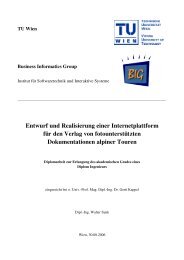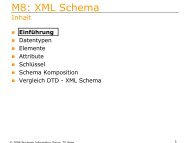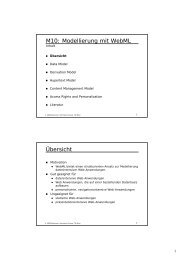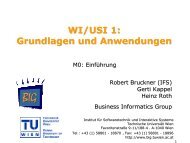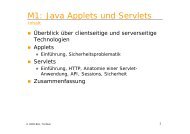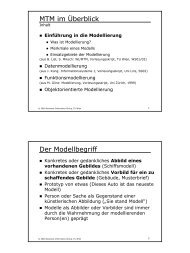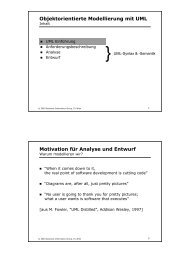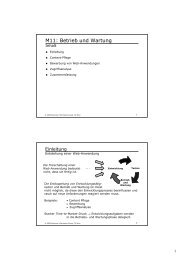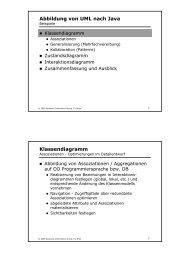Ph.D. Thesis - Business Informatics Group
Ph.D. Thesis - Business Informatics Group
Ph.D. Thesis - Business Informatics Group
You also want an ePaper? Increase the reach of your titles
YUMPU automatically turns print PDFs into web optimized ePapers that Google loves.
2.3 A DTD to Ecore Transformation Framework<br />
In addition, the EReference is annotated with ≪Validate IDREF(S)≫. Furthermore, the<br />
multiplicity of the EReference is set to the multiplicity of the XMLAttribute.<br />
It has to be emphasized that, since this heuristic is based on name matches, two problematic<br />
cases can occur. On the one hand, it may falsely resolve references in case IDREF(S)<br />
attributes are incidentally named like XMLElemTypes but in fact do not reference them.<br />
On the other hand, it may not be possible to resolve a reference in case IDREF(S) attributes<br />
are not named according to the XMLElemType they shall refer to. Consequently, the user<br />
has to validate if the resolution of the IDREF(S) is correct or if another EClass should be<br />
referenced.<br />
Example. In the running example, the XMLAttribute entity in Figure 2.9(a) is resolved<br />
to an EReference in Figure 2.9(b). In case no name match is found, the IDREF(S)typed<br />
XMLAttribute is transformed into an EAttribute of type EString annotated<br />
with ≪Resolve IDREF(S) manually≫, such as the superEntity EAttribute in Figure 2.9(b).<br />
<br />
<br />
<br />
<br />
(a)<br />
Step 2: Application of Heuristics<br />
relationship<br />
ENTITY<br />
id:EString<br />
name:EString[0..1]<br />
superEntity:EString[0..1] «Resolve IDREF manually»<br />
persistent:EBoolean=“true“«Validate Boolean»<br />
1 entity<br />
0..*<br />
RELATIONSHIP<br />
id:EString<br />
name:EString[0..1]<br />
minCard:EString<br />
maxCard:EString<br />
Figure 2.9: Example of Applying the Heuristics (Step 2)<br />
Heuristic 2 - Boolean Identification<br />
«Validate IDREF»<br />
Heuristic 2 is based on the assumption that an XMLEnumAtt consisting of two XMLEnum-<br />
Literals might represent an attribute of type Boolean (cf. 2.2.3 Limited set of data types).<br />
It recognizes such optimization possibilities and, instead of generating an EEnum, produces<br />
an EAttribute of type EBoolean for the following sets of enumeration literals: {true,<br />
false}, {1, 0}, {on, off}, and {yes, no}. Furthermore, an annotation ≪Validate EBoolean≫ is<br />
added to the attribute. In case the two XMLEnumLiterals are not one of the aforementioned<br />
sets, the produced EEnum is annotated with ≪Resolve possible EBoolean type manually≫,<br />
indicating the possibility of replacing the EEnum by the EBoolean data type.<br />
Example. In the running example, the XMLEnumAtt persistent is identified to be of type<br />
Boolean (cf. Figure 2.9(a)). Thus, in the metamodel, the EAttribute persistent is of type<br />
(b)<br />
31



